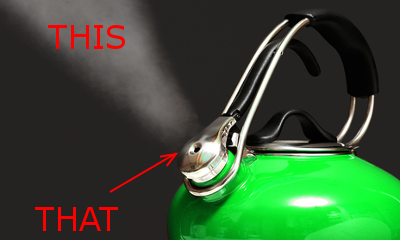For years I was led to believe that there was a fundamental difference between these three things:

 However, I recently read a report on the constituent of “smoke” and discovered that one of the main ingredients of what we call “smoke” is water. And indeed, if you burn hydrocarbons (compounds with hydrogen and carbon) such as wood then you inevitably get CO2 and H2O. So there is a lot more in common between smoke and these things:
However, I recently read a report on the constituent of “smoke” and discovered that one of the main ingredients of what we call “smoke” is water. And indeed, if you burn hydrocarbons (compounds with hydrogen and carbon) such as wood then you inevitably get CO2 and H2O. So there is a lot more in common between smoke and these things:
This leads me to wonder whether there is a certain amount of academic dishonesty in the oft repeated asserting that “steam” is not the same as smoke. Or that the only “steam” is the bit lacking any obvious “steam” at the top of the kettle.
Because surely if clouds need condensation nuclei – things on which the cloud droplets form, then surely the “smoke” from a kettle also needs condensation nuclei. And is “smoke” really just steam – that happens to form on the much fainter and in many cases almost transparent “soot” given off by the fire?
In short, it appears the three essential ingredients for all these phenomenon are the same:
- Water vapour
- Condensation nuclei
- Low enough temperature
Thus the reality is that smoke & steam are in fact two variants of the same thing.



Water doesn’t have to have something carbon based to form droplets. Sand dust is just as good and forms the basis of quite a lot of rain. Sea salt (probably the biggest source of nucleii I’m guessing). A nucleus doesn’t need to be very big and once formed, the drop itself is a nuleus. Where carbon is involved it doesn’t need to be burnt. It might be skin, fur, pollen, soil (carbon and non carbon), etc. Smoke on the other hand has much larger quantities of carbon.
Technically steam is invisible. Condensate isn’t just a feature of temperature but pressure as well. On joining a power station for the summer I was given the mother of a ll safety inductions with tales of people sliced inhalf and/or set on fire by the heat of high pressure steam.
If we were starting from scratch thinking up names for things like smoke or steam, we might come up with something more accurate but the words were defined before the science.
The original meaning of “steam” in old English included “hot breath” which is well below 100C. So steam is what we see coming out a kettle. It’s use for invisible water vapour was a later and arguably false use whereas the use for that we see is the correct usage.
I don’t disagree and QI often irks me by using the obscure rather than the commonly used, but then it’s supposed to.
If what you say is true, I need to start worrying whether vaping in hotel rooms will set off the smoke detector. It hasn’t done for the last five years.
One of the major differences:
Smoke is evaporated water and “self contained” particulates from the fire itself – it creates its own condensation nuclei
Steam from a kettle (or vapour, if you prefer) is the evaporated water condensing on already present particulates – the kettle contributes nothing (or infinitesimal amounts) to the condensation nuclei.
The more I look at the subject – the more complex it all becomes and I’m less and less convinced that there is the clear cut ABSOLUTE distinction that naive children are taught at school.
Indeed, there seems to be many intermediary states from fog, to smog, to wood “smoke” – BONE DRY wood smoke (almost colourless), rubber tire “smoke” (which is clearly something very different)
Indeed, I am reminded on my “more words for rain” article – in that perhaps there are more types of smoke/steam/cloud than I had ever imagined.
Yes – the school definition IS for children to understand.
From a perspective of child psychology, children need defined structure to understand; limits, definitives, no grey-area thinking, A and B and C (rather than “A and B are the same thing seen from different view positions and C now appears to be unrelated to A or B”)
The truth is that reality is not A or B or C it’s Aa AA Aab ABA aba aBa ACB abc aCb…
Grey areas that merge and separate as you observe them.
How do we even relate to things like the mist over a lake with the heat-mist over a hot road in a summer rain shower? In essence, they are the same thing, as is the mist you see when you breathe out a puff on a cold night….
It’s an interesting concept – “smoke” doesn’t really exist becasue the major component of it is the same water vapour as a kettle or our breath… the particulates might be only 5% of the actual output (?).
Scottish-Sceptic says:
The more I look at the subject – the more complex it all becomes and I’m less and less convinced that there is the clear cut ABSOLUTE distinction that naive children are taught at school.
JMcG:
I think your instincts are on target.
Sorry if this adds to the confusion:
http://www.thunderbolts.info/forum/phpBB3/viewtopic.php?f=10&t=16647
and
http://www.thunderbolts.info/forum/phpBB3/viewtopic.php?f=10&t=16329&start=165#p122122
James McGinn / Solving Tornadoes